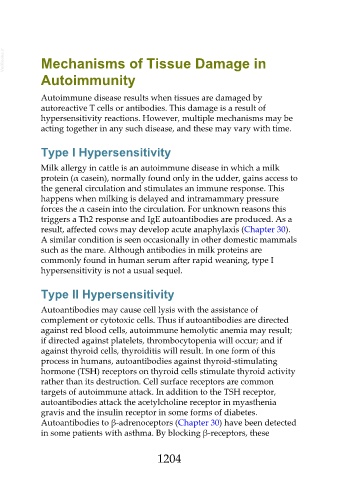Page 1204 - Veterinary Immunology, 10th Edition
P. 1204
VetBooks.ir Mechanisms of Tissue Damage in
Autoimmunity
Autoimmune disease results when tissues are damaged by
autoreactive T cells or antibodies. This damage is a result of
hypersensitivity reactions. However, multiple mechanisms may be
acting together in any such disease, and these may vary with time.
Type I Hypersensitivity
Milk allergy in cattle is an autoimmune disease in which a milk
protein (α casein), normally found only in the udder, gains access to
the general circulation and stimulates an immune response. This
happens when milking is delayed and intramammary pressure
forces the α casein into the circulation. For unknown reasons this
triggers a Th2 response and IgE autoantibodies are produced. As a
result, affected cows may develop acute anaphylaxis (Chapter 30).
A similar condition is seen occasionally in other domestic mammals
such as the mare. Although antibodies in milk proteins are
commonly found in human serum after rapid weaning, type I
hypersensitivity is not a usual sequel.
Type II Hypersensitivity
Autoantibodies may cause cell lysis with the assistance of
complement or cytotoxic cells. Thus if autoantibodies are directed
against red blood cells, autoimmune hemolytic anemia may result;
if directed against platelets, thrombocytopenia will occur; and if
against thyroid cells, thyroiditis will result. In one form of this
process in humans, autoantibodies against thyroid-stimulating
hormone (TSH) receptors on thyroid cells stimulate thyroid activity
rather than its destruction. Cell surface receptors are common
targets of autoimmune attack. In addition to the TSH receptor,
autoantibodies attack the acetylcholine receptor in myasthenia
gravis and the insulin receptor in some forms of diabetes.
Autoantibodies to β-adrenoceptors (Chapter 30) have been detected
in some patients with asthma. By blocking β-receptors, these
1204

